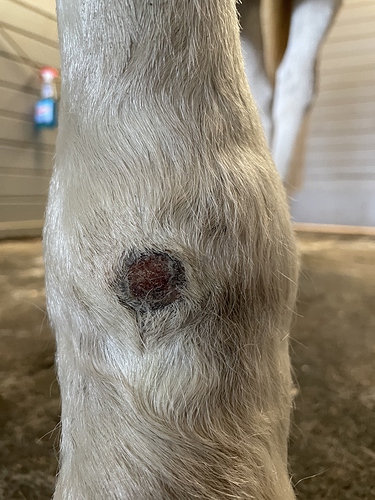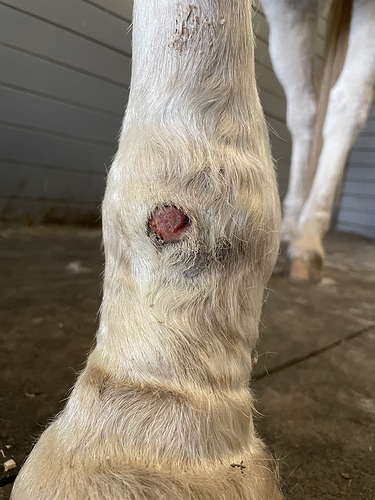Simkie, it’s definitely hyper-granulated. I’ve had good luck with preparation H or just cortisone cream reducing the proud flesh and allowing it to epithelialize but it does come back each time she reopens it
I wonder if it might be worth more aggressive debridement to take it back to a level, healthy wound bed? 
Definitely looking better after a few days in a standing wrap. I bought her a pair of new fetlock boots and switched to elasticon and vet wrap infer the boots. I’ll report back with a product review. I will say the packaging says “one size fits all” but they barely reached around my not uber heavy boned warmblood’s pasterns.
COTH wisdom gave me the idea for hock sores of a big dollop of Bickmore’s, a piece of non stick pad over the salve, and then a piece of duct tape over all that and some. Working like a charm.
Have you tried Underwoods wound topical? You put baking powder on top of the underwoods when you apply it and it covers the wound like a bandaid.
Is that the back or front of the fetlock?
Almost looks like a summer sore which can be really tough to heal. I would try to treat it like a summer sore and see if that does the trick. Oral ivermectin, then daily topical ivermectin/cortisone. Keep rapping.
I haven’t had problems with fetlock sores, but hock sores in a few horses. Different things work for different horses. Whatever you can get to cover and stay until scabbed over and dry. If humid and warm I use wonder dust for a couple of days to stop too much moisture and granulation. One thing no one has mentioned that works for me is once they dry and scab over, I do not cover but put New Skin on. It comes in a bottle or spray. I coat twice over. Once before I ride and once after. I sometimes shave the fur around for better stick too. Once scabbed and dry this seems to really work. It won’t promote granular tissue but provides a thick barrier to the rub area.
While you’re wrapping, 100% recommend hydrocolloid dressings. They are SO awesome for stuff like this. They don’t stick well enough on their own to use without a wrap, but are just stellar to use under one. Pick up a box or two from Amazon!
Would these work on hocks?
If you could find a way to wrap over them, maybe?
I’m having good luck at the moment with Mepilex dressings. I cut a small square to fit the sore so I can make one Mepliex bandage last a while. I asked a nurse what the hospital uses on bed sores, etc. and that’s what she recommended.
I’ve tried applying moist ointments, alushield, wound shield sprays, etc. on fetlock sores and really nothing helps to heal it except let it dry out and keep it from re-opening however you can. I found just the fetlock shield or just the wrap aren’t enough and I need both a small wound pad and the fetlock shield.
I tried every fetlock sore solution known to man on my old gelding including the upside down pull on bell boot trick. A few of the sore specific neoprene boots worked well but they were destroyed in a couple of weeks time. The solution that finally ended the problem for him was using natural gum rubber bell boots. I don’t know exactly why that made such a difference but it did. They are generally a softer material and thicker at the bottom edge than a regular rubber bell. YMMV. I can’t remember what brand I used…KL select possibly …but they were also a bit on the tall side for him which also helped.
Ugh, my mare has one right now. She is super hard on herself in turnout, so I’ve basically given up on wrapping any of her ouchies. We use these (https://www.doversaddlery.com/horsesox-individual-pack/p/X1-041661/) with quite good success! I do a Wound-Kote or Alushield underneath.
I was taking care of a horse with big ones like this. The turnout boots I mentioned helped once it was healed (but that was hard to get to because she also would open them up in the stall). I used a hydrophilic foam dressing under Elastikon. Kept on for a few days depending on how much serum oozing there was. To help protect the hair and skin being bandaged, I would sometimes apply Vetrap and the. elastikon, with the Elastikon only on hair for a little bit, to keep it from moving around too much. At night, standing bandage.
You have to get it healed enough to not split open just from contact with the inside of a boot even. Elastikon will protect against some wet/muddy conditions but you may have to change more often. Putting a turnout boot over would help some with that.
These wound pads would not stick but would absorb any oozing. I didn’t put any ointment on the wound generally which would have only caused the bandage to slip around more easily.
New boots seem promising- they stayed on fine, it remains to be seen if they will be enough protection to keep her from reopening the wound once it’s healed. Simkie- thanks for the hydrocolloid dressing suggestion. I’ll definitely be upping my wound care game  Hopefully it will start to epithelialize without needing to be debrided back to a clean wound bed but that may be needed. I’ve never used gall salve before but I might give it a try to toughen up those wound prone areas once everything looks well healed.
Hopefully it will start to epithelialize without needing to be debrided back to a clean wound bed but that may be needed. I’ve never used gall salve before but I might give it a try to toughen up those wound prone areas once everything looks well healed.
Wound bed ay end up needing some debridement but I’m going to give it a little more time with wrapping and see how it progresses.
As my horse has struggled with this problem for years I’d recommend these bell boots from Horze. They are very thick neoprene and have actually held up pretty well for over a year. They’re called Horze Pro Overreach, and I got mine from Amazon https://www.amazon.com/Horze-Pro-Bell-Neoprene-Boots/dp/B07CJMTQVV
That’s looking better!
Does that wound bed extend up past the skin margins, though? It looks like it does in this pic.
If it does, I’d be awfully tempted to debride with Adolf’s meat tenderizer for ONE night, and see how that looks. Based on this pic, there’s not much to remove, but taking it down juuuuust a little could make a big difference in healing. (Or talk to the vet about cutting it down?) Slap a hydrocolloid dressing on top, wrap, and leave the dressing until it’s coming off on it’s own. It should last a few days if you’re wrapping over it. I bet it will be SO much better!
Here are the hydrocolloids I buy: https://www.amazon.com/Dynarex-Dynaderm-Hydrocolloid-Dressing-Count/dp/B00U1H9H60 They come in all different sizes, but 2x2 would work fine here! SO handy, I love them.
I didn’t even know fetlock sores were a thing, but I found one on my mare last night! I had no idea how she got a sore on the front of her fetlock, so I assumed she rubbed it on something or caught it on a stick, etc. She had hock sores in the past while stalled at night, but they are healed since she stays turned out. So I’m not sure how she would have gotten this, unless the area she’s choosing to sleep in at night has something that irritates. I swear, if it exists as a thing, this mare either has it or is going to get it. She is the most high maintenance horse I’ve ever owned. Right now I’m also dealing with huge scabby sores on her mane and tail head, plus huge itchy bumps (I assume bad reaction to some kind of bug bite), all over the rest of her body. One day she was fine, the next all this. And now, yet another wound to manage.
It’s a good thing she’s gorgeous, since she has some neuro issues that make her unrideable as well. She’s just a walking vet bill.
If your horse has neuro issues this is possibly a symptom. Usually they do it while laying down on a harder surface. Or not laying down to sleep enough and crashing down in front when the body tries to go into deeper sleep while standing / failure of the stay apparatus.



